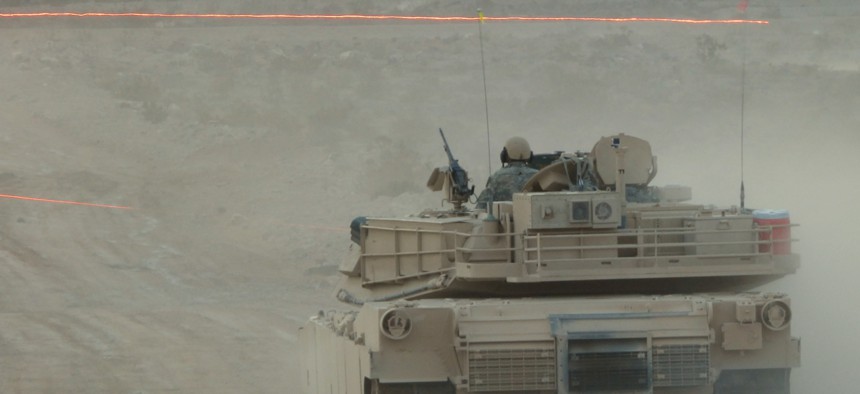
Tracer fire whizzes by an Army Abrams tank during a Joint Forcible Entry Exercise on Aug. 5. Marcus Weisgerber/Defense One
Army Holds Massive Drill To Show Off Its Lethality
After spending 14 years fighting insurgents in Afghanistan and Iraq, the U.S. Army is preparing for a hybrid war.
FORT IRWIN, Calif. – As the setting sun paints the Mojave Desert mountains a striking red, six Abrams tanks roll toward an enemy stronghold, their massive treads kicking up billows of dust.
Suddenly, red tracers whiz across the sky; then a tank’s cannon answers with a thunderous, heart-stopping blast. As the glow of the sunset dims, three Apache helicopters arrive, pouring rocket fire on enemy vehicles at the mountain’s base. Another truck appears, this one with rocket-propelled artillery. Then a flash of light and the whistling sound as the rockets obliterate their target.
On the other side of the mountain, Army special operations forces hide in the foothills, peering out at an enemy airstrip. Their objective: secure the runway so special forces can land. Air Force F-15E Strike Eagles soaring above bomb a handful of enemy targets. Then CV-22 Ospreys fly in, dropping off Army Rangers. They clear the runway, and MC-130 cargo planes swoop with even more Rangers. Thus fortified, the ground force takes out the remaining enemy, allowing more than 500 82nd Airborne paratroopers to drop in from Air Force C-17s and C-130s.
Here at the National Training Center – a sprawling and rugged military complex about the size of Rhode Island, positioned about halfway between Los Angeles and Las Vegas – the Army is preparing for what it calls a hybrid war: a battle against a mix of traditional military and militant fighters. Examples might include the type of war Russia has waged in Eastern Ukraine and the one Iran is supporting in Yemen.
Army leaders say this week’s scenario illustrates how it would secure land at the beginning of a conflict. The Army hasn’t forced its way into a country since it invaded Iraq in 2003, but its generals want aggressive world leaders to know that U.S. soldiers can still fight the big war.
“In my mind, this is also about deterrence,” Gen. Raymond Odierno, the Army chief of staff told reporters before the exercise began at dusk Wednesday. “We’re making sure that everybody understands that we have a capability, if we have to, to force our way into an area, if it’s in our nation’s best interest."
The goal of the exercise is to show that the Army could deploy anywhere in the world on short notice, organizers said.
Deputy Defense Secretary Robert Work, who observed the exercise Wednesday night and early Thursday morning, said the Army now has to be prepared for more threats than it has in the past.
“In my view, deterrence is underwritten by demonstrated capabilities,” Work said told the Army generals at an exercise observations post early Thursday morning. “There are very few organizations in the world that would be able to put together an exercise like this.”
Odierno and Gen. Joseph Votel, the head of U.S. Special Operations Command, have been planning the exercise, called the Joint Forcible Entry Exercise, for a year. The drill gives soldiers the rare chance to train with many different types of forces and equipment, and it allowed conventional troops to operate with special forces.
The Obama administration has placed a high emphasis on special operation in recent years, using these elite forces to carry out risky missions. The command has topped out at about 70,000 troops spread across the Army, Navy, Air Force and Marine Corps. While the number is not likely to grow any further, “new capabilities” such as new communications and weapons could be on the horizon.
“I think what you’ll see is more different capabilities and more modern capabilities,” Work said. “I think the [special operations forces] community is in pretty good shape right now.”
For the past decade, most exercises here focused on counterinsurgency and counterterrorism battles, like the ones in Afghanistan and Iraq where soldiers were deployed en masse. The military has become very comfortable operating in those countries, Votel said.
While smaller numbers of soldiers deploying to Afghanistan and Iraq will still train for those specific fights in the coming months and years, other brigades will train for high-end, hybrid war.
“What’s important tonight is we’re exercising this integration in a different scenario than we probably have over the last several years,” Votel said.
Votel, an Army Ranger, said drills like this would give U.S. leaders a portfolio of military options down the road. “We want to be able to provide options for our leadership so we’re not limited to the things we can do,” he said. “An exercise like this really does give us the opportunity to flush that out a little bit and think through the aspects of how we would do this if we were asked to do it.”
Organizers say the exercise is not specifically geared toward Russia, China, Iran or North Korea, but it does incorporate scenarios the military could face fighting in all of those countries.
“As we look at the world today, there’s many different places that are incredibly unstable,” Odierno said. “It’s up to us to have the capability to go anywhere, anytime, no matter what continent it is.”
The Army “needs to rebuild its combined maneuver skills, which have atrophied,” Work said on an early-morning flight back to Washington.
Dozens of Army generals and senior Pentagon leaders, including Work and acquisition chief Frank Kendall, showed up at the exercise. Gen. Mark Milley, the incoming Army chief of staff, was on hand as well. Milley is the head of Army Forces Command, the organization that oversaw this week’s exercise.
“This is something we probably want to do on an annual basis because of the difficulty of it and also to continue to show people we have the capability,” Odierno said.




